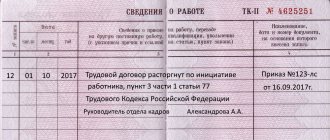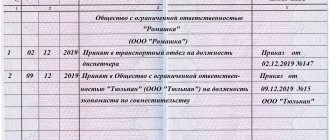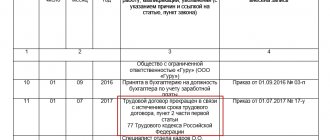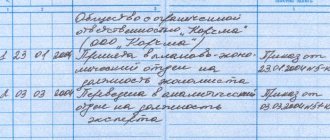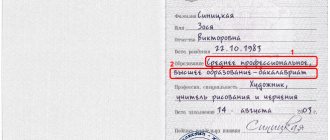18.06.2019
0
209
6 min.
Even experienced HR or accounting employees make careless mistakes when filling out documents, and as a result, the entry in the employment record is invalid. No one is immune from the notorious human factor. Inspectors sometimes hastily indicate the wrong order number or date when dismissing an employee. It should be noted that the work book does not tolerate erroneous entries. The law provides for such cases, so the personnel officer must be able to remove them correctly. The article talks about how to do this in accordance with regulations.
Procedure and sample for correcting an invalid entry in the work book
Using this example, you can track the following points that must be taken into account when entering data indicating that the entry is erroneous:
- You must indicate the number of the incorrect formulation.
- You need to refer to the document number confirming the error.
- It is necessary to indicate the date the incorrect entry was made and the date of correction, so that the wording can be declared invalid and the error corrected in accordance with the rules. So, to summarize the above, what records can be considered incorrect:
- Not true. For example, an erroneous phrase about the dismissal of an employee was entered.
- Incorrectly formatted and not in accordance with the official style of filling out the work book.
- Incomplete, for example, one in which there is no order number or no date of issue of the order, etc.
General rules for correcting errors
For incorrect data in information about work and awards, strikethroughs, erasures, amendments, etc. are not applicable. You can only write down that the data entered under a particular number is invalid, and then add the correct information.
When correcting errors on the first page, it is allowed to carefully cross out the incorrect data and add the correct data next to it. The cover page must refer to documents that contain correct information.
Corrections are made with a blue or black ballpoint pen (gel or fountain pen is acceptable) with light and moisture resistant ink. Words must be written in full, without abbreviation.
Changes made to the title page
The title page includes information about the employee
When filling out this column, it is important to make all entries correctly and in full.
When changing the first name, patronymic, last name (for example, upon marriage), as well as the date of birth, the following actions are carried out:
- old data is crossed out with only one line}
- then new data is written}
- on the cover, on the inside, a reference is made with the number and date of the document (this could be a passport, marriage certificate, etc.) and this is certified by the signature and seal of an authorized person.
But what to do if the entry in the work book was made incorrectly, and a mistake was made in writing the last name, first name or other data? Then there are two possible solutions to this problem:
- If a mistake is made when filling out the title page of the book for the first time, then a corresponding act is drawn up, and the damaged form is destroyed. Usually, the employer does not charge money from the employee for a damaged form.
- If the error was discovered much later, then the most correct way out of this situation would be to go to court to recognize the ownership of this work book.
Such changes are sometimes made precisely at the place of work where the mistake was made, or even at the current place of work, but with a document from the employer who made the mistake. In this case, changes are made in the same way as when changing data.
But it should be remembered that the option of making changes without going to court is controversial and can be considered as non-compliance with the norms for maintaining work records.
It’s also worth asking how the employer determined that this work record belongs to the person who provided the passport? There are namesakes in the world who may even have the same name and date of birth.
New entries about profession or specialty, education
Very often, when filling out a work book for the first time, an employee may not have graduated from an educational institution by that time. Then in the work book it will be entered in the “education” column, for example, “incomplete higher education.” In this case, upon receiving a diploma, the employee must contact the employer and ask to make changes to the work book regarding this fact. The same thing happens when acquiring a new profession or specialty. That is, in this case, an addition is made, and not a correction, and the previous data is not crossed out.
It is worth remembering that if you make additions, you do not need to provide a link to certificates or diplomas on the inside of the book.
When studying at a university, you should not leave the “education” line empty at the time of registration of the employment document. Based on a student card, grade book or certificate from a university, a record of incomplete higher education is made.
If an employee finds an error, what should he do?
Typical errors in work books are found by their owners or employees empowered to maintain labor documentation during dismissal, acceptance and revision of personnel documents. One of the most common mistakes: the date in the work book is indicated incorrectly.
If the owner of a trading company finds an error on the employee information page, then he needs to:
- Collect documents with correct information (diploma, passport, marriage or divorce certificate, etc.);
- Submit an application to the manager with a request to correct the erroneous entry;
- If the case concerns the first name, patronymic and last name incorrectly recorded by the previous employer, go to court to prove ownership of the Labor Code and correct the entry.
If the owner of a trading company has discovered an error in the “Work Information” and “Award Information” blocks, then he needs to:
- Submit an application to the head of the organization where the mistake was made with a request to correct the incorrect entry in the Labor Code;
- If the employee has already registered for a new job, then they will not give him a work book for corrections, so you need to submit an application to the head of the organization where the mistake was made, asking for documents (copies of orders, employment contracts, certificates, extracts, etc. ), on the basis of which the new employer can correct the detected errors;
- If the previous organization no longer exists, the documents necessary for correction can be requested from the archives of the city where it was registered.
Invalidity of an entry in labor reasons and legal consequences
The most common mistakes that HR officers make when filling out employment data relate to the wording in the position (staffing unit) specified in the employment agreement. The reason here is elementary inattention, because often the position in everyday life is called by an abbreviated name, but according to the staffing table it comes with a different name. Such an entry in the labor record may lead to inconsistencies with the staffing table with all the ensuing consequences.
This is also important for the employee, because the lack of a definition can reduce the status of a leading employee to an ordinary employee, which can affect future employment and salary
A mistake in a position can have negative consequences for both the employer and the employee.
If there are errors in the wording of the article when dismissing an employee, the same scheme applies, only here the employee suffers to a greater extent. After all, during a further job search, the next employer carefully evaluates the reason for leaving the previous job. There is only one way out - write a statement and demand correction.
Another option, when a previously made entry is declared invalid, is the restoration of the employee’s labor rights by the court or the Labor Inspectorate.
When an employee is reinstated at the enterprise by a court decision, an entry about this is made in the work book.
The most difficult option is when, when registering the transfer of a specialist to another position, the personnel officer enters a work record and certifies it with the manager’s visa and the company’s seal. This is a gross violation of the rules for drawing up an employment document, since the signature of management and the company’s stamp can only be placed on the document upon dismissal of an employee. In fact, such a record is not considered a record, and accordingly, it is impossible to invalidate it. This text cannot be corrected. In this case, you need to change the work permit, drawing up a duplicate with the correction of this error.
When an error creeps into the title page of the work book, where information about the employee is indicated, the consequences can be the most serious. A discrepancy between the personal data in the work book and other documents may make it invalid, since its ownership will be in question. If the error is not corrected, such a document may not be accepted by the Pension Fund as confirmation of work experience. This can happen if the title page contains:
Typos or errors
This is especially important when registering your full name.
Oh, here a mistake in one letter, an omission of a letter, and even the letter “e” instead of “e” can play a key role. Cross-outs or corrections without reference to the relevant documents of title. Correcting data by covering it with correctors or erasing it with an eraser. A note on the issue of a work book by an individual. According to current regulations, an employer who is an individual. person (not an entrepreneur), does not have the right to issue employment documents, nor to record in them the fact of working for him. Other information that does not correspond to current documents.
The ownership of a work book with incorrect personal data can be established in court, but this will require some effort.
Responsibility for errors in filling out the form
Clause 45 of the Rules indicates the employer’s responsibility for maintaining, recording, storing and issuing employment documents. Management by order (or instruction) appoints a person whose duty will be to make and change records.
According to Art. 5.27 of the Code of the Russian Federation “On Administrative Offenses” No. 195-FZ dated December 30, 2001 (last edition of the document - April 3, 2018), violation of the current legislation entails a fine in the amount of:
- for officials - from 1000 rubles. up to 5000 rub.;
- for individual entrepreneurs – from 1000 rubles. up to 5000 rub.;
- for a legal entity – from 30,000 rubles. up to 50,000 rub.
You can avoid mistakes in paperwork by being attentive to the duties performed. Knowledge of the rules and basic legislative acts will protect you from fines and sanctions from the state.
Correcting an entry made
Correction of the information contained on the title of the work book can be done following the instructions and rules governing its completion. In this case, you need to carefully cross out the error with a horizontal line and write the correct option next to it. After this, the entry in the work book can be considered invalid.
Completion of a perfect record
You can cancel a completed entry for various reasons. This is especially true in situations where a company employee, upon joining the job, had one higher education that was different from his job, but over a certain period of time he graduated from another educational institution and received the corresponding profession. This means that the HR department employee must ask himself how to properly cancel an entry in the work book made earlier. In this case, you don’t have to cross out the entry, but simply add the information that appears, separated by commas.
Invalidity of entry
It happens that after making any entry in the work book, in particular, information about the position, date of employment, dismissal date, awards to the employee for special merits, etc., it is discovered that the entry is incorrect. A logical question arises: how to write in the work book that the entry is invalid?
You cannot cross out anything in these sections, nor can you falsify information or cover it up with a corrective agent. An entry stating that an entry in the work book is considered invalid must be made in a strictly defined manner.
This procedure should be completed by repeating the number and date of the order in column 4, on the basis of which the work book was filled out incorrectly. If this order was drawn up with an error, it should be cancelled. After this, enter the details of the canceled order in column 4.
According to this principle, corrections are made to all incorrect or inaccurate information, in particular, about employment, transfer to another department, dismissal, as well as various types of awards received by the employee during the period of his employment with each employer. An entry that is recognized as such by a decision of the court, the Rostrudinspectorate or the employer itself is also invalid. This is especially true in cases of dismissal or transfer of an employee.
https://youtube.com/watch?v=UgjGFi6_h8A
Additional questions
The employee is asked to create a work book if he has another one
In rare cases, an employee asks to issue a new document if he already has a valid book. A few examples of employees who may want to create an additional form:
- a teacher who teaches classes at different universities;
- a doctor who sees patients in both private and public clinics;
- security guard employed at 2 places of work on different shifts
An employee can create several documents, expecting material benefits from different organizations. The law does not clearly prohibit such actions. However, it can be argued that only one copy is legal. Art. 282 of the Labor Code of the Russian Federation provides a clear definition of the concept of “part-time work”. Only one place of work can be the main one.
A citizen is listed as a part-time worker on the basis of an agreement with the organization. The Labor Code also guarantees support for citizens combining work with study, but only at their main place of work. One place of work is also taken into account in relation to benefits for workers in the Far North and hazardous industries. Information about part-time work is entered into the subordinate’s papers. The number of organizations in which a person can work part-time in his free time from his main job is not limited by law.
Registration of a duplicate
If an employee's book is lost, he must report it as soon as possible. The employer must issue a duplicate within 15 days from the date of application.
The duplicate includes:
- information provided at the last place of employment;
- data on total work experience before joining the staff
If the lost form contained a mark that was declared invalid, it will not be duplicated in the new copy. The total length of service is indicated in summary, without specifying the organizations in which the subordinate was registered and the reasons for dismissal.
A duplicate is issued if the employee’s book is lost or damaged. A duplicate may be issued if the original version contains an erroneous entry about the dismissal or transfer of an employee. In this case, erroneous information is not entered into the duplicate.
Errors related to information about past jobs must be corrected by the organization that made the mistake. If the organization is reorganized, the problem is solved by the successor. In the event of liquidation of the company, the correction is made by the responsible person at the current place of employment.
Information about the probationary period is not included in the list of employment of the subordinate, since the employee is not yet officially working in the company, and the law does not indicate the need to record such data.
When making notes, both the full and abbreviated name of the employer is written down in the document. If an error is made in the name of the organization (even if it concerns only the abbreviated name), a note is made in the documentation with up-to-date information.
According to clause 35 of the Rules, the seal of the organization, as well as the signature of the responsible person, certifies all records of this organization in the form upon dismissal of an employee. The owner of the work book signs each entry. The seal is also placed on the title page. If the stamp is placed upside down, this is not considered a violation. The notice of dismissal is made on the day the employee is dismissed. If a subordinate went on vacation before leaving the organization, the date of the last day of vacation (also the date of the last working day) is entered in column 3. The reason for dismissal must include a reference to the clause and article of the Labor Code of the Russian Federation.
Other information included in the form
Similar to information about work, column 3 of the form includes information about:
- taking advanced training courses, retraining and special training;
- receiving a new rank (category);
- part-time employment;
- the time spent in places of deprivation of liberty is not subject to offset in the total work experience;
- period of military service or service in internal affairs bodies;
- restoration of continuous service
How is the situation regulated when it is necessary to consider an entry in a work book as invalid?
The situation we are studying is regulated by the following regulations:
- Labor Code of the Russian Federation (hereinafter referred to as the Labor Code of the Russian Federation) in terms of the correctness of determining the grounds for dismissal and other information (for example, Chapter 13).
- Clause 22 of Section I, Section III of the Rules for maintaining and storing work books, approved. Decree of the Government of the Russian Federation dated April 16, 2003 No. 225 (hereinafter referred to as the Rules), which specifies the general procedure for correcting shortcomings.
- Clause 1.2 of Section 1 of the Instructions for filling out work books, approved. Resolution of the Ministry of Labor of the Russian Federation dated October 10, 2003 No. 69 (hereinafter referred to as the Instructions), which provides a detailed list of specific actions to change the contents of the work book.
However, not all possible errors have been addressed by the legislator, so most of these problems are resolved:
- in accordance with established practice in personnel records management;
- by analogy with the examples described in legislation;
- independently by personnel workers.
What does the law say?
As stated above, errors in this document are rare.
And their discovery must be accompanied by mandatory correction, which is provided for by labor laws and government regulations.
In particular, the possibility of correction is indicated by instruction number 69, drawn up in October 2003 by specialists from the Ministry of Labor and Social Development.
This takes into account the peculiarities of storing work books, reflected in government decree number 225, issued in April 2003.
All corrections must be made taking into account the requirements specified in the listed regulatory documents.
General rules for correcting incorrect entries in the work book
The primary postulate of maintaining a work record book: nothing should be crossed out or covered up! Any corrections are made only by invalidating the erroneous entry.
Important! This postulate does not apply to the contents of the title page, since filling out this part of the work book is regulated by separate rules. The error is corrected by the employer who made it or the organization in which the citizen works at the time the incorrect entry was discovered
In the second case, the employee must submit papers justifying the correction and coming from the former employer or other official organization. According to the rules governing the procedure we are studying, only original documents are allowed, not copies.
The error is corrected by the employer who made it or the organization in which the citizen works at the time the incorrect entry was discovered. In the second case, the employee must submit papers justifying the correction and coming from the former employer or other official organization. According to the rules governing the procedure we are studying, only original documents are allowed, not copies.
If the former enterprise is reorganized, then the legal successor corrects the incorrect entry or submits the foundation paper. If it is liquidated (this also applies to employers - individual entrepreneurs), then changes are made at the current place of work, and at the request of the employee, the employer is obliged to help in collecting the necessary documents.
Any sources other than witness testimony are used for evidence. The latter are taken into account if the changes are due to court decisions or there has been a massive loss of work books by a separate organization (paragraph 2, paragraph 29, section III of the Rules).
Who can contribute
The employee is not authorized to independently make entries (hereinafter also referred to as marks, inscriptions), correct or supplement them.
Introduction, modification or addition are carried out by the employer at the main place of work.
For these purposes, the head of the organization, by issuing an order, appoints a responsible person (usually a specialist from the human resources department).
After identifying the person authorized to make the appropriate adjustments, the citizen needs to identify a specific employer who has the right to invalidate the mark.
All necessary information is given in clauses 26 – clause 28 of the Resolution:
This is also important to know:
How to competently quit your job: at your own request, by agreement of the parties, at the initiative of the employer
| What needs to be changed | Where to contact |
| Full name, date of birth, add or change education, profession, specialty | To the employer at the current place of work, presenting him with the relevant substantial document - passport, birth certificate, marriage certificate or dissolution of marriage, etc. |
| Incorrect mark contained in the “Work Information” or “Award Information” section | At the request of the worker - either to the employer who made this incorrect entry, or to the employer at the current (last) place of work. In the latter case, you need to provide an official document from the employer who made the mistake |
| Incorrect mark if the employer who made it was reorganized | To the successor of the reorganized company |
| An incorrect entry if the employer who made it was liquidated | To the employer at the current (last) place of employment, presenting him with an official document confirming the liquidation |
Correction method
If we are talking about sections of the book that contain information about work or awards, the law does not allow crossing out incorrect or erroneous information. In this case, correction is made by invalidating the erroneously entered data and then displaying the correct information.
A similar procedure is also followed when an error is identified regarding the registration of an employee’s dismissal, transfer to another permanent job, and in cases where the dismissal is subsequently recognized as illegal.
}
Clause 29 of the Rules provides for an exception regarding the grounds for entering information. If an employer loses employee records on a massive scale due to an emergency, witness testimony can be used as a basis for entering information.
Who has the right to correct?
An entry in the work book about a change of surname or an entry about the category in the work book can correct a rather limited circle of people. This cannot be done without special powers and without a reason. If errors are found in the Labor Code, they are corrected at the previous or current job and in court.
Not a single regulatory document provides a list of positions for which the exclusive right to make, certify and correct entries in the Labor Code is provided. The Rules only clarify that those responsible for such work in the organization are appointed by a special order.
If the organization is small and does not have a separate personnel service, either the employer himself or any specialist appointed by his order can maintain and correct work books: an accountant, secretary, administrator, office manager, etc.
If work is provided by an individual, the law does not allow him to maintain and correct work books.
Eligibility to make changes
All kinds of errors and inaccuracies when filling out books must be corrected immediately after detection. The longer the period of time passes from the moment of entering erroneous data, the more difficulties arise with the provision of relevant supporting documents.
The simplest option is when the discovery of inaccurate (erroneous) wording and its subsequent correction occurs at the place of work where it was introduced. This significantly simplifies the procedure for collecting relevant supporting documents and practically does not affect the “injured” employee.
Another option is} when the inaccuracy is discovered during the period of employment with a new employer. In this case, it is also possible to make appropriate corrections, but only if there are official documents from the employer who made the mistake. The main work of collecting and providing a supporting base in this case falls on the shoulders of the employee himself.
However, in any case, in accordance with paragraph 27 of Resolution No. 225 of April 16, 2003, the employer is obliged to provide the necessary assistance when an employee formally applies with a request to make an entry in the work book about the invalidity of the entry.
General formal requirements for making adjustments
These rules include:
- Data must be entered legibly and in clear handwriting.
- The bases are written in full; abbreviations and abbreviations are not allowed.
- Entries may be made in black, blue or purple ink.
- It is forbidden to use gel pens as they do not withstand exposure to light and water.
- It is not allowed to erase or cover up errors with a proofreader.
- It is prohibited to cross out or shade erroneously entered text in the work book. And the title page is no exception. Yes, here you can cross out the text, but not the erroneous one, but the one to which corrections confirmed by documents are made.
- On all other sheets, in order to correct incorrect information, you need to make a comment about the invalidity of a certain entry indicating its number and then write down the correct data. Moreover, if an error is found, for example, in entry number four, and the personnel officer fills out the seventh entry, the line indicates that entry number 4 is invalidated.
- Dates are entered into the document in Arabic numerals strictly in the format “dd.mm.yyyy”.
Invalid entry on the title page of the work
It is almost impossible to invalidate entries on the title page of an employment document. There are only two options here: correct the error and certify the correction, or completely replace the document.
As regulated in subparagraphs 2.3 and 2.4 of the Resolution of the Ministry of Labor of the Russian Federation No. 69 of October 10, 2003, only three types of adjustments are allowed to be made to the title page spread:
- Corrections of the employee's last name, first name or patronymic (with the obligatory availability of supporting documents).
- Clarification of the date of birth of the owner of the work record (also with reasonable evidence).
- Corrections or additions to the record of information about qualifications obtained, education, etc.
Incorrect employee data is crossed out with a horizontal line, and the correct version is written next to it. On the inside cover, a note is made that an error was made, and the document on the basis of which the correction was made is indicated. The record is certified by a seal (if any) and the signature of the person keeping work books at the enterprise, with a transcript.
Corrections in the employee’s personal data are certified by the signature of the responsible person and seal
The problem with re-registration of a work permit can be solved quite simply if a mistake was made during the first employment of the employee
In this option, the employer (note - at his own expense) must issue a new form to the person and register it in the personnel records of the enterprise. An incorrectly filled out book is considered damaged and is disposed of according to the appropriate act.
The situation becomes more complicated if there were previous places of work, then when registering a duplicate employment record you will need to contact your former employers and restore all records. The personnel officer does not have the right to make records about the employee’s previous places of work in the accounting document retroactively.
Often, an employee who has been issued a duplicate to replace a work book that has been declared invalid is faced with the problem that the new document does not reflect all places of employment, and therefore the information in the duplicate work book may be incomplete. And this is allowed by law (see paragraph 32 of the Rules approved in Resolution No. 225 and paragraph 7.2 of Resolution No. 69). Experience can be confirmed by other documents, the list of which is regulated by paragraph 11 of the Rules, approved by another order of the Government of Russia - No. 1015:
- a signed copy of the employment agreement with the employer;
- certificates, for example, 2-NDFL, which were issued to the employee at previous places of work;
- extracts from orders;
- employee's personal accounts;
- payslips recording the payment of wages.
Video: errors on the title page of the work book
The calculation of pension payments largely depends on the correct execution of the work record book; each period lost due to the fault of the employer hits the pockets of already not very wealthy pensioners. And the legal requirements for the personnel service in particular and for the employer in general are to facilitate from all sides the correct and accurate representation of a person’s work activity in this document.
How to correct an incorrect entry after dismissal
If an incorrect entry is discovered by a person who has already resigned from the place of work where the error was made, he should contact this particular company. This is the easiest way to record a discrepancy and correct the error. If the former employer does not make contact, you can resolve the issue in court. But this is a rather lengthy process that will require a lot of time and effort (at least to collect evidence). On the other hand, such a claim can result in appropriate compensation and even (if desired) reinstatement at work.
But when an erroneous entry appears after a fairly long period, and even more difficult - when the enterprise no longer exists and there is virtually no one to ask, there is another way. The first step is to secure the support of your current employer. If a person is employed, the employer is simply obliged to try to correct the mistake or recognize the document as invalid and prepare a duplicate work record book for the person.
But when restoring a document from the last place of work, a person may have certain difficulties confirming work experience in previous places. After all, the employer has the right to enter into the employment document only data that is 100% confirmed by documents. And this can only be done after receiving official answers from former employers or data from the archive (if the company has been liquidated). And this is a rather complex and lengthy process. But we note that the legislation regulates this issue and agrees that labor gaps in a duplicate work book are acceptable. This conclusion can be made on the basis of paragraph No. 32 of the Rules, ratified by normative act No. 225, as well as by Decree of the Government of the Russian Federation No. 69 (see paragraph 7.2). Thus, these acts regulate that, together with a duplicate, a person’s work experience can be confirmed by one of the following documents:
- original employment contract;
- financial certificates and statements recording the fact that the employee received payment for work at a specific enterprise (for example, certificate 2-NDFL, other payment forms that are issued upon dismissal);
- orders on employment and dismissal;
- monthly payslips in which the salary amount is recorded.
This register of documentation accompanying and confirming work experience is also indicated in the latest Decree of the Government of the Russian Federation on this topic - No. 1015 (clause 11).
As a last resort (if the company is liquidated), there is archival data where you can get a certificate and an extract from the labor record book, which can prove that a labor register with certain details was issued.
A small nuance: if, when hiring, it was discovered that there is no organization stamp in the labor register of the hired employee, when restoring this gap, you need to carefully consider the seal imprint. If suddenly the name or legal status of the company has changed over the past period, it is prohibited to put an updated seal. Inconsistencies between the name of the company indicated in the register and the seal will automatically invalidate the document. The solution here should be the following - to justify that at the time of receiving the work book the person was working here. This means that you need to have a document on hand indicating this, for example, a certificate-extract from the journal of the movement of work books or a 2-NDFL certificate for that year or other documents confirming the fact of employment.
How to make an entry in the work book about the invalidity of the entry
The sample is contained in paragraph 1.2 of the Instructions and represents the following algorithm of actions:
- In column 1 (“Record number”): enter the number next in order to the last record.
- In column 2 (“Date”): enter the full date (hh.mm.yy) when the correction occurs.
- In column 3: enter the following text “The entry under No. (indicate the serial number of the incorrect entry) is invalid.” The line below indicates the correct option, that is, what the entry should actually look like.
- In column 4: indicate the main details of the document (name, number and date) confirming the information in the correct entry.
For information on how to make changes to a work book, watch the video List of the most common mistakes Additional information The employer preparing a work book has several requirements, including storage requirements.
